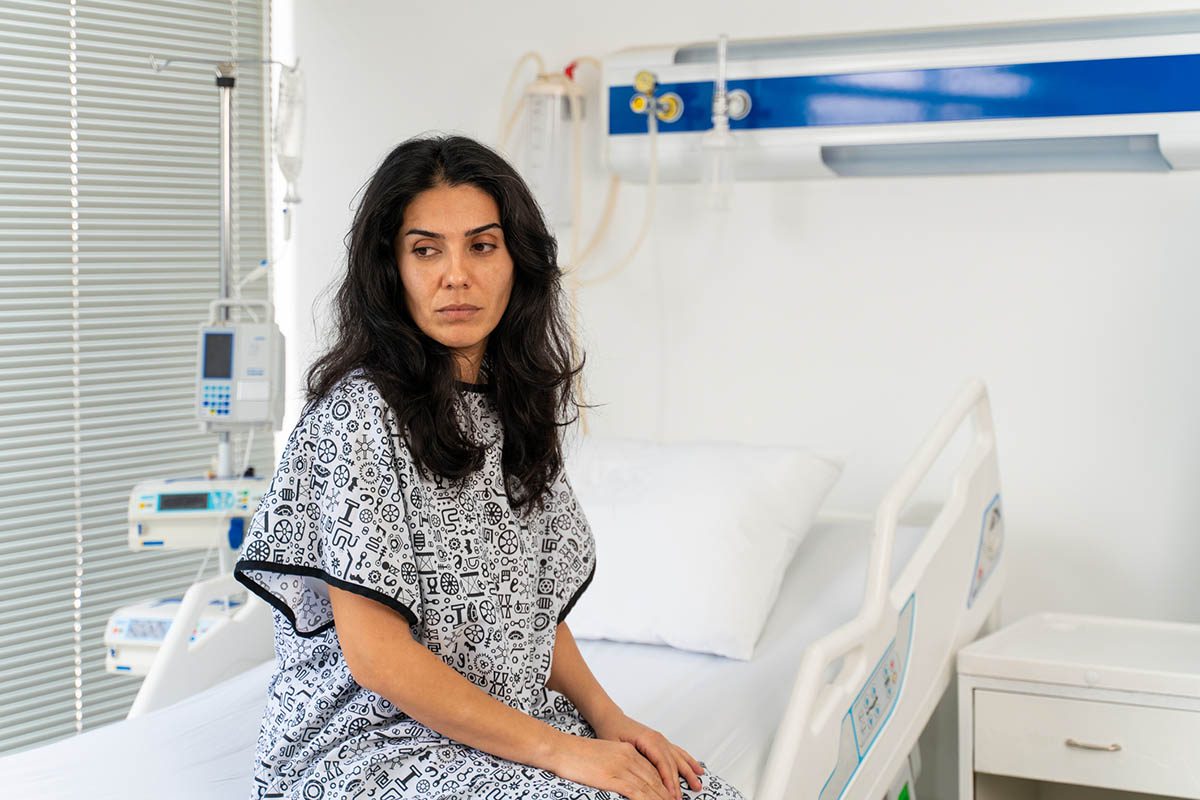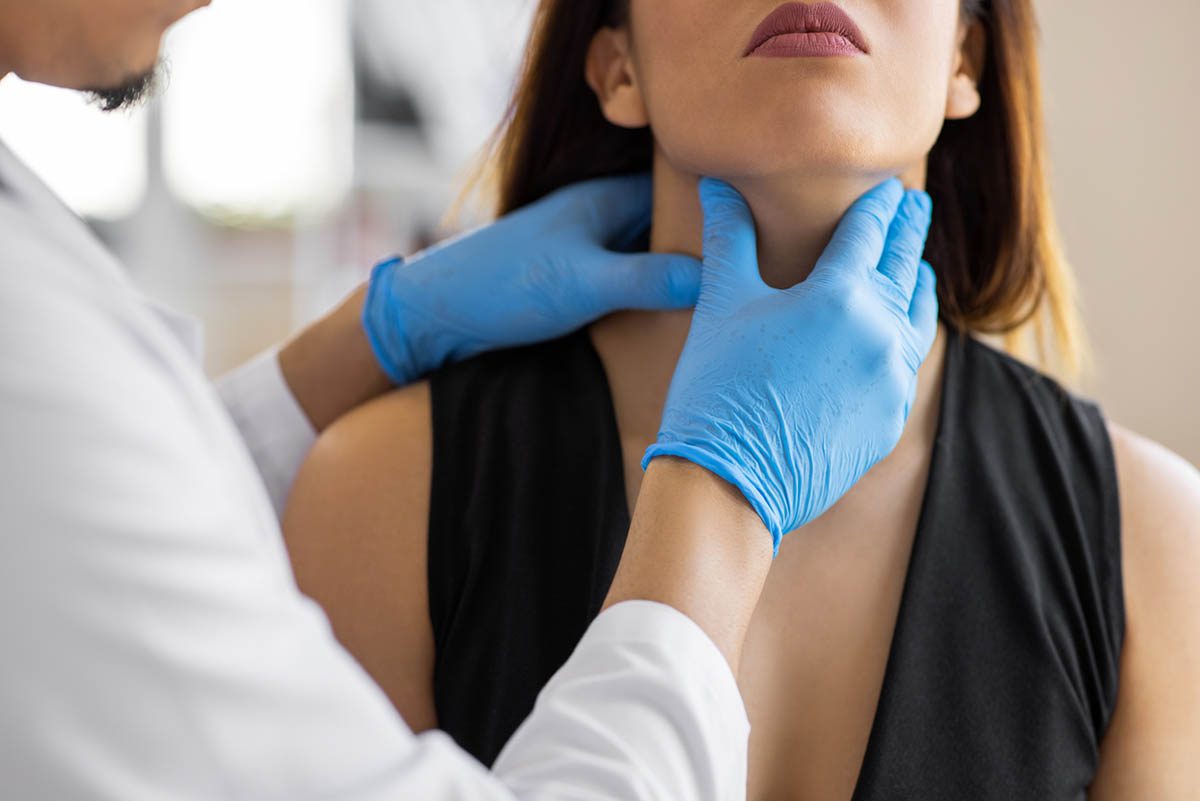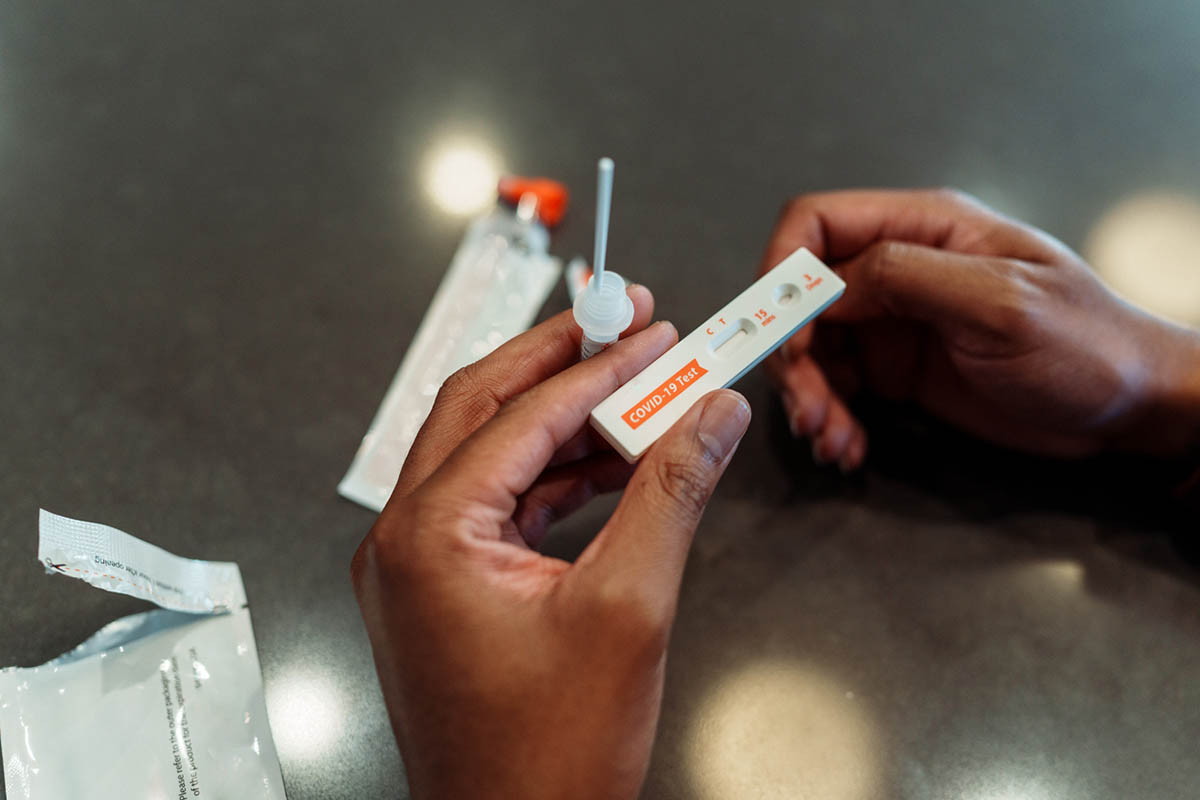To date, there have been more than 800 million confirmed cases of severe acute respiratory syndrome coronavirus 2 (SARS-CoV 2) infection globally, including 6.9 million deaths.1 Numerous reports have detailed neuropsychiatric sequelae of COVID-19 infection, including cognitive impairment, depression, and anxiety. There have also been several reports describing catatonia in the setting of COVID-19 infection. However, these reports have primarily been described in adults and have been associated with the acute phase of COVID-19 infection.2 There are limited but growing reports of catatonia associated with acute COVID-19 infection in pediatric patients3–5 and in the post-acute phase of COVID-19 infection in adults.6–8 Varying definitions of “post-acute” or “post–COVID-19” conditions led the World Health Organization (WHO) to issue a clinical case definition for a post–COVID-19 condition in children, which can be summarized as symptoms causing functional impairment that initially occurred within 3 months of confirmed or probable SARS-CoV 2 infection and that have lasted at least 2 months.9 We present a case of catatonia in a young pediatric patient associated with the post-acute phase of SARS-CoV-2 infection.
Case Report
A 4-year-old girl with a history of high-functioning autism spectrum disorder (ASD) and no significant medical history presented to her primary care provider for cough with confirmed SARS-CoV-2 infection. Two weeks after diagnosis, she began a 10- day course of amoxicillin-clavulanate for lingering sinus symptoms, which ultimately resolved. Four weeks after diagnosis, she appeared less interactive and engaged in uncharacteristic behaviors such as lying on the ground and repeatedly covering her ears and eyes. Over the next few weeks, she exhibited a dramatic reduction in meaningful speech, increased repetitive purposeless movements (jumping and rubbing limbs on objects), increased repetitive speech, grimacing, gait changes, ambitendency, and urinary incontinence. Three months after initial diagnosis, she was admitted to a tertiary care academic medical center for further workup. Blood, urine, and cerebrospinal fluid (CSF) studies—including autoimmune, paraneoplastic, and infectious CSF panels—were unremarkable except for low ferritin (3.3 ng/mL). Antistreptolysin O titer was negative. Magnetic resonance imaging of the brain and spine was unremarkable. Electroencephalogram showed slow and disorganized background but was otherwise unremarkable. Rapid whole-genome sequencing, including mitochondrial DNA sequencing, was unremarkable. Given the negative workup, she was discharged home.
At this point, catatonia was suspected, and empiric treatment with oral lorazepam was started and gradually increased to 0.7 mg 3 times daily. Seven days after beginning lorazepam, she had her first formal evaluation in the outpatient child and adolescent psychiatry clinic. At this visit, she displayed motor excitement; constant stereotypies; frequent mannerisms, grimacing, and impulsivity; and occasional mutism, posturing, echolalia, verbigeration, negativism, ambitendency, and perseveration. She scored 21 on the Bush-Francis Catatonia Rating Scale (BFCRS).10 During this visit, her parents reported that since starting lorazepam, she had become more interactive, and her gait had become more fluid. Contemporaneous laboratory workup showed elevated creatine phosphokinase (252 U/L).
Over the course of several months, lorazepam was titrated to a maximum of 8 mg daily in divided doses. Treatment with lorazepam was associated with further improvements in meaningful speech and ambitendency, as well as resolution of echolalia, mutism, verbigeration, and perseveration. Unfortunately, relative to baseline, symptoms of excitement, posturing, stereotypies, mannerisms, and impulsivity persisted, albeit improved from onset. At higher lorazepam doses, she displayed increased emotional lability and apparent fatigue; therefore, her dose was gradually decreased. Her BFCRS scores were serially monitored, gradually decreasing from an initial score of 21 to a score of 7 at 84 days posttreatment initiation at a total daily dose of 5.5 mg. Eventually, lorazepam was tapered off at the request of her parents, who opted to pursue treatment with steroids. At the time of the last contact in our clinic and after initial steroid treatment, she had not yet returned to her baseline.
Discussion
To our knowledge, our patient is the youngest to date to be diagnosed with catatonia associated with SARS CoV-2 infection. Previous cases have been documented in adolescents as young as age 15 years. Our case is also unique given the onset of catatonia occurred 4 weeks after initial laboratory diagnosis of SARS-CoV 2 infection and persisted for >3 months, which meets the WHO’s case definition for a post–COVID-19 condition in children and adolescents.9
There have been multiple studies describing the neuropsychiatric sequela of COVID-19. Impaired concentration, memory loss, sleep difficulties, and increased risk for mood disorders, anxiety disorders, and posttraumatic stress disorder have been reported.11,12 The incidence of catatonia associated with SARS-CoV-2 infection remains unclear. A study13 using the 2020 National Inpatient Sample reported a discharge diagnosis of COVID-19 infection co-occurred in 3.7% of hospitalizations for catatonia, but the study also noted potential issues with recognition of catatonia and COVID-19 and likely errors in diagnostic coding of catatonia. Cases of mild or post-acute SARS-CoV-2 infection associated with catatonia, such as our case, may be underreported Given the suspected association between catatonia and SARS-CoV-2, several causal mechanisms have been proposed. Ong et al14 recently published a review of the proposed mechanisms of neurological complications of post-acute COVID 19, which supports hypotheses related to SARS-CoV 2 neuroinvasion, hypoxia, and immune dysregulation. Spiegel et al7 previously reported a case of catatonia associated with postacute SARS-CoV-2 infection in a 59-year old patient with an initially severe infection, in which they hypothesized increased vulnerability to catatonia may arise from reduced dopamine neurotransmission following the entry of SARS-CoV-2 to the brain and subsequent neuroinflammation. Additional hypotheses for a causal mechanism have been made, such as molecular mimicry.15 γ-aminobutyric acid (GABA)ergic intracortical impairment has been observed in patients with post-acute symptoms of COVID-19.16 Interestingly, GABA-A receptor levels have also been shown to be downregulated in brains of individuals with autism,17 which may be related to the limited response to benzodiazepine treatment in our patient. It is unclear whether the mechanism by which SARS-CoV 2 infection precipitates catatonia might differ from the numerous other medical conditions that have been associated with catatonia in the literature. It is also worth noting that catatonia is relatively common in patients with autism18; therefore, an infection such as SARS-CoV-2 may be regarded as an additional insult in patients who are at a likely higher vulnerability for catatonia.
It is also unclear whether the patient’s partial response to benzodiazepine treatment is at all related to SARS-CoV-2 infection status, the timing of treatment for catatonia after initial onset, or her comorbidity of ASD. Partial response to benzodiazepine treatment for catatonia is well-documented. In a prospective naturalistic cohort study of 66 children and adolescents with catatonia, benzodiazepines were effective in 65% of cases when used, with greater clinical response associated with less severe initial symptoms of catatonia and with acute onset (<10 days) of catatonia symptoms.19 Numerous studies have documented the association between ASD and catatonia.20 The delayed diagnosis of catatonia by approximately 2 months after onset of behavioral regression in the current case is worth noting and underscores frequent missed or misdiagnosis of catatonia in both psychiatric and general medical settings.21–25 In a case series26 of 22 patients with ASD and catatonia, most patients had partial or no response to benzodiazepine treatment and were ultimately treated with electroconvulsive therapy (ECT). ECT has been documented to successfully treat catatonia associated with COVID-19 in several adults2,27 and in an adolescent.5 ECT has been shown to be effective for treating catatonia in young children, although this modality has not specifically been studied in treatment of catatonia associated with COVID-19. Given the patient’s young age and her family’s preference, ECT was not pursued in this case.
This case highlights the risk of catatonia as an underlying etiology for the clinical presentation of behavioral regression during the post-acute phase of SARS-CoV-2 infection in a young child, especially when there is a comorbid neurodevelopmental disorder or ASD. Furthermore, as the delay in treatment was approximately 2 months after initial onset of behavioral regression, the adverse effect of delayed treatment cannot be ignored. It is recommended that young patients presenting with behavioral regression around the time of SARS-CoV-2 infection be monitored for catatonia and for consideration of treatment with benzodiazepines, with ongoing monitoring for the need for further interventions, such as ECT, as needed.
Article Information
Published Online: January 9, 2025. https://doi.org/10.4088/PCC.24cr03796
2025 Physicians Postgraduate Press, Inc.
Prim Care Companion CNS Disord 2025;27(1):24cr03796
Submitted: June 23, 2024; accepted September 12, 2024.
To Cite: Van Pay A, Mohiuddin S, Ghaziuddin N. Catatonia associated with post-acute COVID-19 in a young child. Prim Care Companion CNS Disord. 2025;27(1):24cr03796.
Author Affiliations: Department of Psychiatry, University of Michigan, Ann Arbor, Michigan (Van Pay, Mohiuddin, Ghaziuddin); Trinity Health IHA Medical Group, Ypsilanti, Michigan (Van Pay).
Corresponding Author: Andrew Van Pay, MD, Trinity Health IHA Medical Group, 5301 McAuley Dr, Ypsilanti, MI 48197 ([email protected]).
Relevant Financial Relationships: None.
Funding/Support: None.
Patient Consent: Consent was received from the patient’s guardian to publish the case report, and information has been de-identified to protect anonymity.
References (27)

- COVID-19 WHO. Accessed June 17, 2024. https://covid19.who.int/
- Dawood AS, Dawood A, Dawood S. Catatonia after COVID-19 infection: scoping review. BJPsych Bull. 2022;47(4):1–12.
- Kopishinskaia S, Cumming P, Karpukhina S, et al. Association between COVID-19 and catatonia manifestation in two adolescents in Central Asia: incidental findings or cause for alarm? Asian J Psychiatr. 2021;63:102761. CrossRef
- Nayagan J, Oh J, Sanzone K, et al. (33) COVID-19 and pediatric catatonia. J Acad Consult Liaison Psychiatry. 2022;63:S128–S129. CrossRef
- Holland E, Choudhury N, Putinta K, et al. Successful ECT in an adolescent with catatonia and psychosis due to COVID-19. Psychiatry Res Case Rep. 2023;2(1): 100129. CrossRef
- Torrico T, Kiong T, D’Assumpcao C, et al. Postinfectious COVID-19 catatonia: a report of two cases. Front Psychiatry. 2021;12:696347. PubMed CrossRef
- Spiegel DR, Kisteneff A, Fidelis W, et al. A case and proposed mechanism of catatonia during the post acute phase of severe acute respiratory syndrome coronavirus 2 infection. Prim Care Companion CNS Disord. 2022;24(3):21cr03233. PubMed CrossRef
- Bajwa JS, Fu A, Mirabelli MH. Delayed onset catatonia after COVID-19. Psychiatry Res Case Rep. 2022;1(2):100043. PubMed CrossRef
- Behnood S, Newlands F, O’Mahoney L, et al. A Clinical Case Definition for Post COVID-19 Condition in Children and Adolescents by Expert Consensus. WHO; 2023. Accessed June 17, 2024. https://iris.who.int/bitstream/handle/10665/366126/WHO-2019-nCoV-Post-COVID-19-condition-CA-Clinical-casedefinition-2023.1-eng.pdf?sequence=1
- Bush G, Fink M, Petrides G, et al. Catatonia, I: rating scale and standardized examination. Acta Psychiatr Scand. 1996;93(2):129–136. PubMed CrossRef
- Nakamura ZM, Nash RP, Laughon SL, et al. Neuropsychiatric complications of COVID-19. Curr Psychiatry Rep. 2021;23(5):25. CrossRef
- Huang C, Huang L, Wang Y, et al. Six-month consequences of COVID-19 in patients discharged from hospital: a cohort study. Lancet. 2023; 401(10393):e21–e33.
- Luccarelli J, Kalinich M, McCoy TH, et al. Co-occurring catatonia and COVID-19 diagnoses among hospitalized individuals in 2020: a national inpatient sample analysis. J Acad Consult Liaison Psychiatry. 2023;64(3):209–217. PubMed CrossRef
- Ong IZ, Kolson DL, Schindler MK. Mechanisms, effects, and management of neurological complications of post-acute sequelae of COVID-19 (NC-PASC). Biomedicines. 2023;11(2):377. PubMed CrossRef
- Vasilevska V, Guest PC, Bernstein HG, et al. Molecular mimicry of NMDA receptors may contribute to neuropsychiatric symptoms in severe COVID-19 cases. J Neuroinflammation. 2021;18(1):245. PubMed CrossRef
- Versace V, Sebastianelli L, Ferrazzoli D, et al. Intracortical GABAergic dysfunction in patients with fatigue and dysexecutive syndrome after COVID-19. Clin Neurophysiol. 2021;132(5):1138–1143. PubMed CrossRef
- Fatemi SH, Reutiman TJ, Folsom TD, et al. GABAA receptor downregulation in brains of subjects with autism. J Autism Dev Disord. 2009;39(2):223–230. PubMed CrossRef
- Wing L, Shah A. Catatonia in autistic spectrum disorders. Br J Psychiatry. 2000;176:357–362. CrossRef
- Raffin M, Zugaj-Bensaou L, Bodeau N, et al. Treatment use in a prospective naturalistic cohort of children and adolescents with catatonia. Eur Child Adolesc Psychiatry. 2015;24(4):441–449. CrossRef
- Vaquerizo-Serrano J, Pablo GSD, Singh J, et al. Catatonia in autism spectrum disorders: a systematic review and meta-analysis. Eur Psychiatry. 2022; 65(1):e4.
- Ghaziuddin N, Dhossche D, Marcotte K. Retrospective chart review of catatonia in child and adolescent psychiatric patients: catatonia in children and adolescents. Acta Psychiatr Scand. 2012;125(1): 33–38.
- Breen J, Hare DJ. The nature and prevalence of catatonic symptoms in young people with autism. J Intellect Disabil Res. 2017;61(6):580–593. CrossRef
- Wilson JE, Carlson R, Duggan MC, et al. Delirium and catatonia in critically ill patients: the delirium and catatonia prospective cohort investigation. Crit Care Med. 2017;45(11):1837–1844. CrossRef
- Llesuy JR, Medina M, Jacobson KC, et al. Catatonia under-diagnosis in the general hospital. J Neuropsychiatry Clin Neurosci. 2018;30(2):145–151. PubMed CrossRef
- Anand S, Kumar Paliwal V, Singh LS, et al. Why do neurologists miss catatonia in neurology emergency? A case series and brief literature review. Clin Neurol Neurosurg. 2019;184:105375. PubMed CrossRef
- Wachtel LE. Treatment of catatonia in autism spectrum disorders. Acta Psychiatr Scand. 2019; 139(1):46–55. CrossRef
- Nikayin S, Chaffkin J, Ostroff RB. Catatonia after COVID-19: a case series. J ECT. 2022;38(3): e43–e44. PubMed CrossRef
Please sign in or purchase this PDF for $40.





